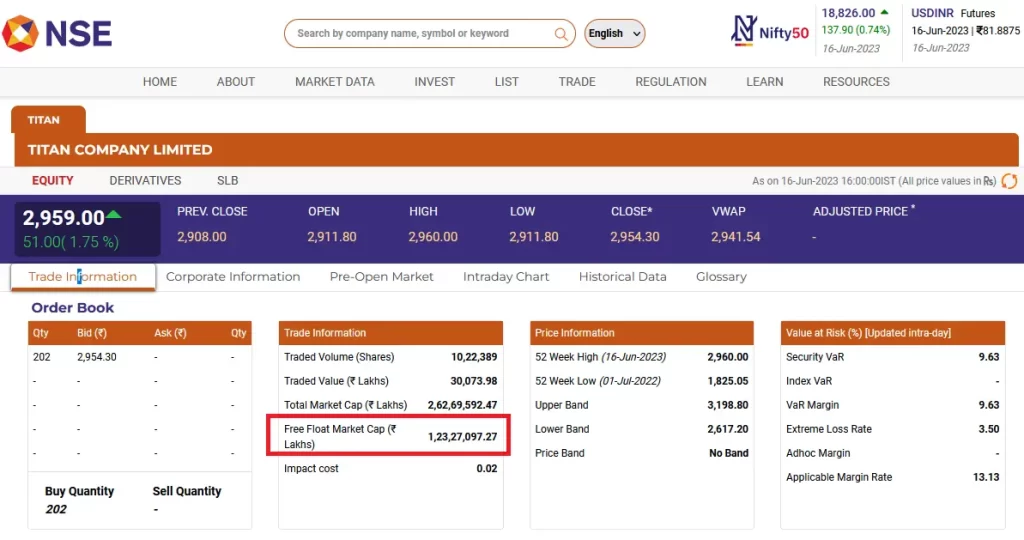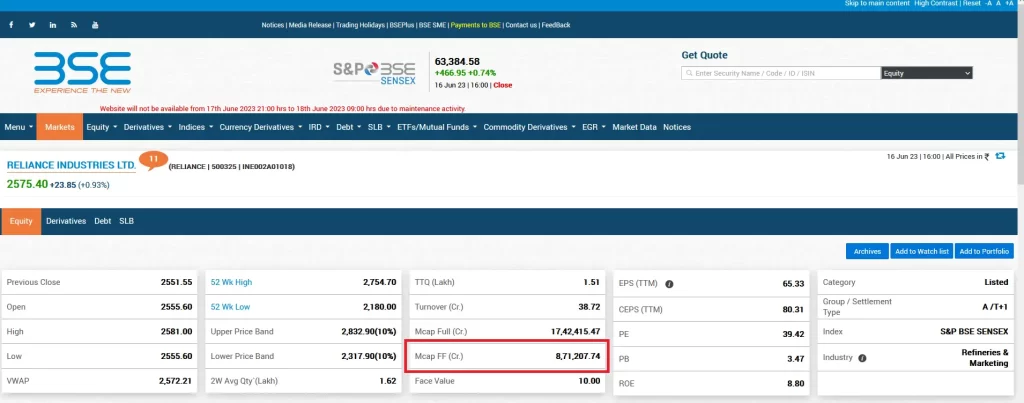There are many ways to calculate the value of a company, one of which is free float market capitalization, which is different from total market capitalization. This post is to help you understand free float market capitalization and how to find the free float of the company you wish to invest in. Free float market capitalization is also an important stock market metric for traders and investors.
Let us first understand what total market capitalization is before jumping into free float market capitalization.
Table of Contents
What is Market Capitalization?
Total Market capitalization is how much a company is worth. Let us take an example of a company called ABC Ltd. ABC Ltd has a total of 100 shares with each share representing 1% of the company.
So the total number of shares is 100. Let’s assume each value of the share is 10rs. So the total market capitalization of the company is given by
Total number of shares x Value (Price)
Which is
100 x 10 = Rs 1000.
So the total value of ABC Ltd is 1000rs. This is known as total market capitalization.
Now let us see how total market capitalization differs from free float market capitalization.
What is Free Float Market Capitalization
Free float market capitalization is similar to total market capitalization, but with a slight difference. Instead of multiplying the value of the stock by the total number of shares as we did in the total market capitalization formula, we multiply it by the total number of shares available to the public, discarding shares that are not available to the public, which could be locked-in shares, promoter holdings, etc. The complete list of shares that are excluded from trading in the open market is listed in the next section.
So Free float market capitalization is defined as the total number of stocks available to trade in the open market multiplied by the price of the stock.
Let us take the same example of ABC Ltd to understand free float market capitalization. As we mentioned before, ABC ltd has a total of 100 shares, with each share trading at a price of 10rs. Now the promoter (owner) of ABC owns 55% of ABC and is not planning to sell their shares for a while. So effectively 55% of stocks are locked and are not available to trade in the open market. So only the remaining 45% of the stocks are available to trade in the open market.
So free float market capitalization of ABC is 45×10= Rs 450.
Free float market capitalization formula = total number of stocks available in the open market x current market price of the stock.
Let’s consider another easy to understand example with an analogy so that even a kid would understand what free float market capitalization.
Imagine a pizza that is cut into 10 slices. This pizza represents the entire value of the company, and each slice represents a share. Your mother has paid for the pizza, and she has told you to keep 6 slices aside for her and her guests who will be visiting later. Now these 6 slices are effectively reserved or locked in. You can do what you please with only the remaining 4 slices, the remaining 4 slices is known as free float.
Locked in Categories:
The following categories are assumed to be locked in and are discarded when calculating the free float market capitalization.
- Shares held by founders/directors/acquirers which have control element
- Shares held by persons/ bodies with “Controlling Interest”
- Shares held by the Government(s) as promoters/acquirers
- Holdings through the FDI route
- Strategic stakes by private corporate bodies/ individuals
- Equity held by associate/group companies (cross-holdings)
- Equity held by Employee Welfare Trusts
- Locked-in shares and shares which would not be sold in the open market in normal course
How to Find Free Float Market Capitalization of a Stock:
Stocks traded in India are traded in NSE or BSE.
In NSE
- Head over to NSE website.
- Search for the name of the stock in the search box at the top.
- For this example lets consider Titan Ltd. The red box in the image represents the free float market cap of Titan Ltd.

In BSE
- Head over to BSE website.
- Similarly search for the name of the stock in the search box at top right.
- For this example lets consider Reliance Industries Ltd. The red box represents the free float market cap of Reliance Industries Ltd.

Why is Free Float Market Capitalization important?
- Free float represents the true market value of the company. By considering only the freely available stocks in the open market it provides a more accurate picture of supply, demand and liquidity. It also shows what the true market sentiment.
- Free float market capitalization is a key metric used by investors to evaluate the investment potential of a company. Investors often prefer stocks with a higher free float market capitalization as it signifies a larger pool of shares available for trading. Higher liquidity associated with a larger free float enhances the ease of buying and selling shares, allowing investors and traders to enter or exit positions more efficiently.
- Free float market capitalization is often used in the calculation of market indices, including popular indices like the Nifty 50, Bank Nifty, Nifty Finance, Nifty Auto etc. Including only the freely tradable shares ensures that the index accurately represents the overall market performance. It prevents the influence of large, controlling shareholders who may have a significant impact on the price movements of a stock but do not necessarily reflect the broader market sentiment.
- Risk management: Stocks with a very low free float would be difficult to exit in case of a loss since they have very low liquidity. Low liquid stocks are also prone to high volatility. So checking the free float market capitalization can act as a risk management check before investing or trading especially in illiquid stocks.




Pingback: Nifty Media Index Stocks List With Weightages in 2023 - Niftystags
Pingback: Nifty Auto Index Stocks Weightage and Analysis in 2024 - Niftystags
Pingback: Nifty Pharma Index Stock Weightage and Analysis in 2024 - Niftystags